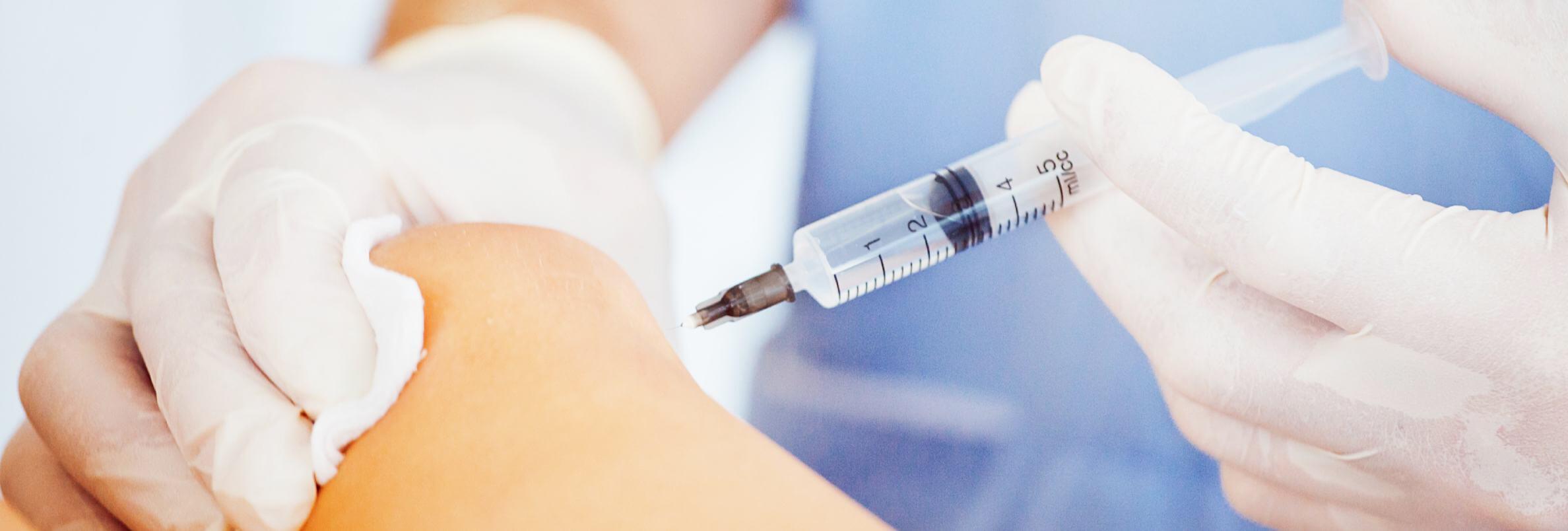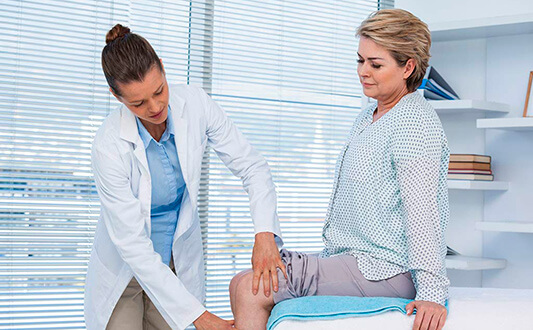Knee osteoarthritis is a common knee disease that manifests itself as chronic pain, dysfunction, and deformation of the joint and gradually leads to its complete destruction. It is impossible to prevent this process. Scientists, however, are constantly working to find new ways to slow down the degradation of articular cartilage, stop it, and even start the regeneration of intra-articular tissue. One of the advanced treatment methods involves the use of hydrogel. It is used as a medicine for intra-articular injections as well as for tissue engineering, with the aim of growing new articular cartilage. The specialists from the Booking Health company tell how doctors in Germany and other developed countries treat the knee joint using hydrogel.
Content
- What is gonarthrosis, and how is it treated?
- Hydrogel as a drug for intra-articular injections
- Hydrogel in tissue engineering
- In what cases can hydrogel be used for arthritis?
- Where can I undergo treatment?
What is gonarthrosis, and how is it treated?
Gonarthrosis (arthritis of the knee joint) is a gradual and slow, but irreversible, degeneration (destruction) of articular cartilage and the underlying bone tissue.
In most cases, there is no obvious reason for the development of the disease. This type of osteoarthritis is considered idiopathic (of unknown origin). It is believed that it is caused by age-related "wear and tear" of the joint. Secondary arthritis also occurs. It most often develops after a knee injury or due to congenital dysplasia, for example, in cases of a frontal knee deformity (X-shaped or O-shaped curvature of the legs).
Gonarthrosis mainly occurs in older people. Among the population over 55 years of age, the prevalence of the disease reaches 10%, and in every fourth case, it leads to disability. However, knee arthritis is also quite common in young people. If under 30 years of age the prevalence of pathology is only 0.2%, then in the age category of 30-39 years it reaches 3.5%.
It is young patients who are candidates for innovative and even experimental treatments that could potentially trigger the regeneration of articular cartilage or at least stop its further destruction. One of the promising areas in arthritis treatment is the use of hydrogel.
Hydrogel as a drug for intra-articular injections
Biopolymer heterogeneous hydrogels are a class of drugs for intra-articular injections. The drug contains the extracellular matrix of embryonic and postnatal (appearing after birth) collagen-containing tissues.
The composition of different drugs differs significantly. Hydrogels may contain the following:
- Partially hydrolyzed collagen peptides
- Glycoproteins
- Proteoglycans
- Uronic acids
- Growth factors
These hydrogels work through two mechanisms. Firstly, like hyaluronic acid traditionally used in orthopedics, they act as a "lubricant" for the knee. As a result of the injection of the drug, friction of the articular surfaces decreases, pain relief occurs, and articular cartilage degeneration slows down. Secondly, the hydrogel enhances tissue regeneration. These are bioactive drugs that stimulate the formation of coarse fibrous connective tissue.
Even after a single injection into the knee, hydrogels provide pain relief and improved knee function that last up to 3 months. Some drugs work for up to 6 months, and there are others that provide effects for up to 12 months.
Doctors achieve the clinical result by increasing the viscosity of the synovial fluid. It is also assumed that the hydrogel stimulates the restoration of hyaline cartilage, synovial membrane, and ligamentous apparatus of the knee, reduces inflammation, and enhances and prolongs the effects of other drugs. Hydrogels are compatible with hyaluronic acid and even increase its effectiveness because they stabilize hyaluronate by forming hydrogen bonds with collagen. The hydrogel has a similar effect on endogenous (produced in the knee joint) hyaluronic acid.
Hydrogel in tissue engineering
Tissue engineering is an innovative area of medicine. This is a technology for growing tissues that are then implanted into the human body.
There is nothing unusual about this technology. It has been used in medicine since the end of the 20th century. In the 21st century, procedures for growing cartilage from a mass of chondrocytes (cartilage cells) or stem cells have become widespread in Germany and other developed countries. They were shaped using the periosteum or a collagen matrix and implanted into the patient's joint using arthroscopic surgery.
Previously, the technology was used mainly for local defects of the articular surface. With its help, they have now begun to treat arthritis, so far only within the framework of clinical trials.
For example, one technique involves implanting a heparin-conjugated fibrin hydrogel with stem cells and growth factors. It is used for a total area of cartilage damage of up to 15 cm2, in the early stages of arthritis without joint deformation.
The treatment method requires two surgical procedures. During the first arthroscopy, a fragment of the synovial membrane is taken, which becomes a source of mesenchymal stem cells. During the second operation, doctors implant hydrogel with stem cells into the area of the cartilage defect. This area is first cleaned of remnants of cartilaginous and fibrous (scar) tissue, and sclerotic (compacted) bone tissue is removed along the edges.
The procedure can be supplemented by applying multiple perforations (holes) so that stem cells come out of the bone into the defect area. This technique has long been used in orthopedics. It is known as the tunneling method. But in its own form, it does not lead to the growth of full-fledged cartilage. The resulting cartilage differs in properties from normal cartilage: it is stiffer, inelastic, and quickly degrades, so the procedure provides only temporary relief of symptoms. But in combination with hydrogel, it can provide better results. By changing the microenvironment, the release of stem cells leads to the formation of full-fledged hyaline cartilage.
In what cases can hydrogel be used for arthritis?
Neither hydrogel-based preparations nor tissue engineering with implantation of a hydrogel into the area of a cartilage defect are considered standard methods for arthritis treatment. Therefore, only a few German hospitals use them. Research is still ongoing to evaluate the effectiveness of this approach.
The following groups of patients can be candidates for using hydrogel:
- Patients with early stages of knee osteoarthritis, if standard conservative therapy does not work (does not provide sufficient pain relief and improvement in knee function)
- In the comprehensive treatment of patients with advanced stages of osteoarthritis: in cases of refusal of arthroplasty, while waiting for surgery, or in the presence of contraindications to arthroplasty
The use of hydrogel should not be the only treatment option. It is used in conjunction with other conservative therapies: nonsteroidal anti-inflammatory drugs, joint injections of hyaluronate and platelet-rich plasma, physical therapy, and physiotherapy.
Where can I undergo treatment?
You can undergo your diagnostics and treatment in Germany. Some German hospitals are already using both hydrogel-based drugs and tissue engineering methods for osteoarthritis.
You can make an appointment for your diagnostics and treatment at a German hospital through the Booking Health website. The Booking Health website presents the best Orthopedic Centers in the world and shows current prices. You can compare the cost of services in different hospitals and choose the option at the best price. When you make an appointment for your treatment in Germany through Booking Health, the cost of treatment for you will be lower due to the absence of additional fees for foreign patients.
Choose treatment abroad and you will for sure get the best results!
Authors:
The article was edited by medical experts, board certified doctors Dr. Nadezhda Ivanisova and Dr. Vadim Zhiliuk. For the treatment of the conditions referred to in the article, you must consult a doctor; the information in the article is not intended for self-medication!
Our editorial policy, which details our commitment to accuracy and transparency, is available here. Click this link to review our policies.
Sources:
Articles for Orthopaedic Practice - Orthogate
Read:
Why Booking Health - questions and answers
How to make right decision when choosing the clinic and specialist
7 reasons to trust to the rating of clinics on the Booking Health portal
Don't know where to start?
Contact Booking Health






